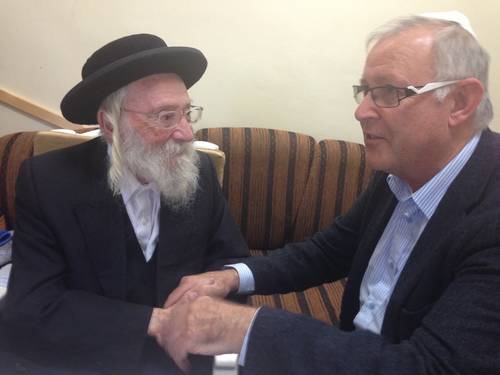  |
  |
|
Shlomo Fischl, survivor from Horažd’ovice (right) with |
Rabbi Salamon with the late Mr Brandt (left), the scribe who repaired the Czech Torah Scrolls for a period of 20 years. |
Our Torah Scroll from Horažďovice resides in the Westminster Synagogue's holy ark with three other Sifrei Torah. The large scroll was written in 1841 and is read by most of our bar and bat mitzvah students.
It was one of the two thousand scrolls that were sent to the Jewish Museum of Prague in 1942. In 1964, with the help of a generous benefactor, 1,564 Torah Scrolls were brought to Westminster Synagogue who subsequently created the Memorial Scrolls Trust to care for them. This Sefer Torah, numbered MST 931, was issued on permanent loan to Westminster Synagogue very shortly after its arrival, and has since undergone further repairs. The mantle is relatively new, the image symbolically representing those who perished in the town of Horažďovice. It is one of 12 surviving scrolls from Horažďovice and its surrounding villages. At least seven were housed in the town’s synagogue, which is no longer standing.
A Jewish presence in Horažďovice is believed to have existed from ancient times and the first written reference to the Jewish community is contained in the records of the Thirty Years' War (1618 to 1648) which indicate that 10 Jewish families were present in 1618. Archival evidence indicates that a Jewish cemetery existed in 1619. The first synagogue and Jewish school were founded in 1684.
Officially banned from guilds, the early Jewish residents were farmers and traders. The earliest Jewish homes were concentrated in an area that is now called Prácheňská Street.
The Jews of Horažd’ovice were subject to orders and decrees that made life extraordinarily difficult throughout much of their history.In the 17th century, the number of Jewish residents in Horažd’ovice was limited to 10 families, partially in an effort to discourage competition for local tradesmen. Renting homes to Jews was strictly prohibited. In the late 17th century, an edict prohibited the Jews from allowing their cattle to graze with the communal herd. In 1687, Jews were targeted further with special taxes, prohibitions on carrying firearms and an edict requiring Jews to wear a yellow cloth badge.
The most far-reaching restrictions on Horažd’ovice's Jews were a series of measures known as the Family Laws "Familianten", introduced by Austrian Emperor Charles VI in 1726 and designed to limit Jewish population numbers. All marriages between Jews required the State’s permission. No Jew under the age of 30 could marry and only the eldest male in each family was permitted to do so.
The repeal of the Family Laws in the mid 1800s launched what many regard as the "golden age" of Horažd’ovice Jewry. By 1890, the Jewish community reached its peak population of 300 – 9% of the total population. The influence of the Jewish community however was far greater as they were the driving force behind much of Horažd’ovice’s Industrial Revolution.
In 1873, Samuel Kohn opened a matchstick factory that produced matches with colourful wax heads in decorative boxes for export to the east. On the adjacent property, a paper manufacturing plant owned by Rud, Firth and Bernard Gans was particularly important as it employed many workers and purchased straw from local farmers. In 1898, Heřman Steiner, Zikmund Friedler and Josef Geschmay opened a starch factory which was so successful that it inspired potato farmers across Bohemia to form an agricultural cooperative, which purchased the factory in 1912. It still operates as LYCKEBY AMYLEX and is the largest producer of potato starch in the Czech Republic.
The best known Jewish business in Horažd’ovice’s was the vinegar and spirits company "Münz Brothers" founded by Simon Münz in 1831 and famed for its "Münzovka" whiskey. Expanded by his sons, Eduard and Karel Münz, and later by František and Pavel Münz, it became the largest distributor of spirits and vinegar in the region and was the sole distributor of almost all foreign wines and domestic mineral waters. In 1859, Heřman Katz founded what was to become the largest grocery mercantile house in southern Bohemia. In 1907, his son Otto Katz founded a wholesale grocery house which was as prosperous as his father’s.
A significant number of Jews emigrated from Horažďovice from 1850 to 1938, particularly to the USA, Australia and South America, some inspired by the community’s international business perspective. Adolph Sabath, emigrated to the US in 1881 aged 15 and served in the US House of Representatives for 48 years representing the 5th Congressional district of Illinois. In 1880, Sigmund Eisner emigrated to the USA from Horažďovice aged 21 with the family sewing machine. By 1922 the Sigmund Eisner Company in Red Bank, NJ became the largest manufacturer of uniforms in the US with over 2,000 employees; it became the exclusive supplier for the Boy Scouts of America after providing uniforms for the Spanish–American War. Signmund's great-grandson Michael Eisner was CEO of the Walt Disney Company from 1984 to 2005.
During World War II, the Jewish Community was deported by German military authorities as part of The Final Solution. 93 Horažd’ovice Jews were transferred via railway on transport Cd to Terezín on November 26, 1942. Six Jews were deported by other means. Only seven survived. No Jewish community exists in Horažd’ovice today.
In 2014, Westminster Synagogue received permission from the town to place memorial stones "Stolpersteine" in front of the homes of Jewish families who were deported by German military in WW II and perished. To date, 15 "Stolpersteine" designed by artist Gunter Demnig have been placed at three homes in two separate ceremonies under the auspices of the Horažd’ovice municipal authority.
Click here to download a copy of 'The Lives of the Jews of Horazd'ovice'.
